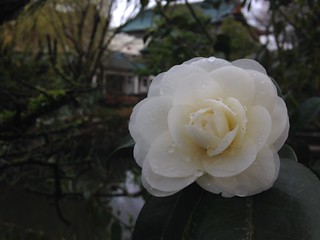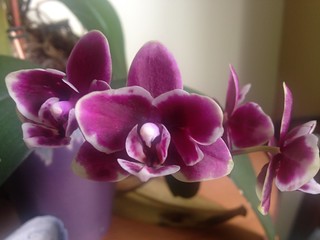
I spent the last two weeks teaching two courses back-to-back:
Oriental Week and
Floriental Week. So naturally I'm a bit obsessed with
white florals right now... This fragrance category is arguably the most popular of all florals, even more than roses. So now seems like an aptly timing to discuss them and shed some light on this concept.
As with most perfumery terms, the name is borrowed from another realm or sense - in this case vision. Most of what we call "white florals" originate indeed in flowers whose colour is white, such as jasmine, gardenia and orange blossom. However, it is not their actual colour that determines whether or not they belong to this category; but rather their chemical makeup and character. Some white flowers don't belong to it, such as lily of the valley, which is actually "green"; while others don't have a scent at all, as the camellia pictured above (taken at Dr. Sun Yat Sen Classical Chinese Garden in Vancouver's Chinatown). Other flowers which belong to this category but are not necessarily white are ylang ylang and jonquille (the first is a creamy yellow-green, and the latter is as bright yellow as its relative the daffodil). Lilies are another great example – even though some lilies are pink or orange (like the tiger-lily), their scent is so heavy and narcotic they would be considered white florals as well.
White florals are characterized by a complex chemical makeup that is experienced as heady, narcotic, heavy and animalic all at once, at times also creamy. On the natural perfumer's palette this includes natural absolutes or enfleurage extractions of jasmine, tuberose, ylang ylang, gardenia, tiare, orange flower, narcissus, jonquile, etc. While the animals component of these flowers can vary from leathery to fecal, they all seem to possess a sweet, fruity, heavy, grape-like quality due to the presence of methyl anthranilate in some amount or another, and they all have
benzyl acetate in common, which is an overall light, white floral, pleasant but rather ethereal molecule, and according to
Jean-Claude Ellena are reminiscent of bananas. I think it also smells a little like acetone.
In his book "
Perfume - The Alchemy of Scent", nose Jean-Claude Ellena defines the characterisic of "white flowers" as relying on the combination of methyl anthranilate and indole, and includes honeysuckle in this category (which is not altogether inappropriate, but to me honeysuckle smells more soapy, fresh and aldehydic). He classifies Ylang Ylang under a "Exotic of Spiced Flowers", alongside lilies and carnation - notes that are characterized by the combination of benzyl salicylate and eugenol. I don't completely disagree with him, but don't agree either.
As a visual representation of the various nuances among the white florals, I like to arrange them in my mind as a circle, each sharing a key quality with the two essences on each side. This is what I like to see in my head:
Narcissus - the greenest of all white florals, and with unusually mushroomy quality. It is floral and even a bit spicy. Very dark and complex and difficult to find and easy to get lost in a composition if not well-proportioned. The animalic aspect here comes from the purring leathery molecule paracresol. There is also an underlying note of coffee and hay which give it a surprising richness and allure. The main constitutes of narcissus: benzyl acetate, methyl benzoate, p-cresol, phenethyl alcohol and indole.
Jonquille - Very similar to narcissus, but a tad more honeyed and sweet. Richly indolic, powdery, animalic and sweet, somewhat green as well.
Tuberose - The creamiest of all white floral, also with green and fungal (mushroomy) aspects, and therefore I like to place it near the narcissus notes (narcissus absolute and jonquille, which by the way, are also tuberose's botanical relatives). The animalic aspect here is paracresol - an acrid, dry, with an almost leathery quality. Tuberose also has distinctive medicinal components, such as methyl salicilate (reminiscent of wintergreen) and camphoreous, eucalyptus-like notes. Alongside the methyl anthranilate grapeyness, it's no surprise many associate it with cough syrup.
Ylang Ylang - Creamy as well, and also shares the paracresol as its animalic aspect with tuberose, as well as the medicinal nuances, but is also more fruity, with banana esters being the most prominent. Ylang ylang also has some spiciness to it, from eugenol. Ylang ylang is also very similar to lilies, which I would place in close proximity to the tuberose and gardenia as well.
Gardenia - very similar to jasmine sambac, but less orange-blossom-like and more creamy and milky fruity qualities. This is of course in relation to gardenia absolute.
Jasmine Grandiflorum - Jasmine shares the fruitiness and jam-like qualities with ylang ylang - only instead of bananas I'm smelling peach and apricot. There is some of the leatheriness of paracresol but it's far more subdued in comparison to the dominant fecal notes of indole and skatole.
Jasmine Sambac - Shares many aspects with jasmine, but with a far more dominant methyl anthranilate quality to it. The indole and skatole are very muted in here. Jasmine sambac is intensely fruity, juicy and exotic, reminiscent of gardenia but far greener.
Orange Blossom Absolute - Methyl anthranilate can really jump up here, but so are other more typical citrusy-floral elements such as linalyl acetate (present in bergamot and petitgrain, among others)
Orange Flower Water Absolute - This links nicely between the orange blossom and back to the narcissus absolute with started with - because it has more green and earthy qualities.
P.s. I've been asked several times since posting this, about which of my perfumes are white florals. So here's a short list of all: GiGi, Moon Breath, Narkiss, Schizm (a Chypre Fantasy), Tamya, Treazon, White Potion, Yasmin, Zohar. Labels: Categorization, Florientals, Olfaction, Organic Chemistry, White Florals











